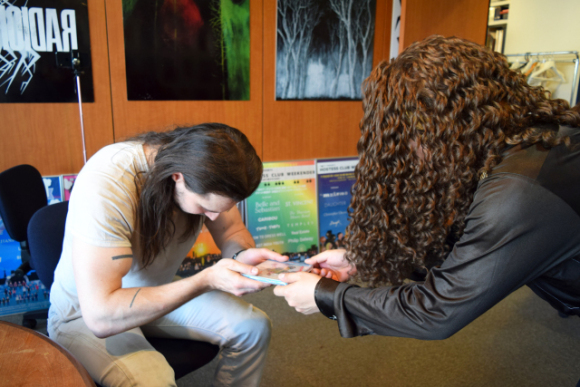
Do you have what it takes to rub shoulders properly in Japan? Not literally though, that would be rude.
It is often said that Japanese culture is among the highest in the world in terms of politeness. Although it helps to make one’s stay here pleasant, in can also be harrowing at times for people from other countries, as there are a lot of unwritten rules people are expected to abide by.
Bear in mind that despite often being described as a culturally homogeneous country, these rules of behavior can vary from region to region and you wouldn’t be hard pressed to find Japanese people breaking them from time to time.
Still, if you want your stay in Japan to be a smooth one, it’s wise to arm yourself with as much knowledge as possible. So, let’s take a little quiz on certain issues of etiquette in Japan and see how much you know about the way things are done here.
These rules are all taken from the book Amy’s Guide To Best Behavior in Japan: Do it Right and Be Polite by long-time Japan resident and culture expert Amy Chavez. It thoroughly covers many social dos and don’ts from basic to advanced as we shall soon see.
So, without further ado, let’s take a trip to Japan!
Congratulations! You’ve landed in Japan but it was an early morning arrival. As you take the long train ride from the airport to the city, you notice very few people riding along with you. Exhausted from your trip, you decide to catch some Zs on the train, so you…
A – Kick off your shoes and lay across the seats. It’s nearly empty anyway.
B – Just let it all loose and manspread your way to dreamland, even if you aren’t a man.
C – Cross your legs politely and lean your head back.
D – Change your mind and stay awake. Only savages sleep on a train.
If you answered D, then you need to loosen up a bit. It’s very common for people to sleep on the train here. However, if you answered A then you really need to slow your Mustang down there Sally. According to Amy, it’s a pretty egregious faux pas to put your feet up on the seat under any circumstances south of a serious leg injury.
So with the two remaining, B would be your best option. Neither is preferable to sitting properly, but crossing your legs in most situations is generally frowned upon for a few reasons such as creating and impression of arrogance and leaving your dirty soles suspended midair, essentially all up in everyone’s face as far as Japanese people are concerned.
BEST ANSWER: B
Of course the reason for your trip to Japan was to hang out and go drinking with Mr. Sato, because what other reason is there to come? In the restaurant you split a large bottle of sake while Mr. Sato regales you with his adventures such as the time he got a haircut in Turkey.
When he gets to the part about the hot towel, you happen to notice his glass is half full – or half empty depending on how you see things – so you…
A – Ask him if he wants to be topped off
B – Do nothing
C – Take the initiative and fill up his glass without asking
D – Ask if he’s had enough
Even though it may seem rather forward to push alcohol on someone, Mr. Sato would prefer C in this instance. Actually, as we’ve seen time and time again, he isn’t that hung up on etiquette and probably wouldn’t care that much either way. However, when dealing with a person you don’t know, keeping their glass full is generally the best course in Japan.
By the way, if you find yourself on the receiving end of never-ending refills, Amy recommends just leaving your glass full as much as possible. It’s a much smoother solution than actively refusing someone’s attempt to refill your glass.
BEST ANSWER: C
You polished off that last bottle and Mr. Sato still hasn’t gotten to the one about marrying an anime dude, so you decide to order another. To do that you would need a waiter, so you…
A – Start waving your hands in the air
B – Shout “Sumimasen! (Excuse me!)”
C – Get up and go find the waiter
D – Just wait until they come to you
This is actually the one area where I’ve heard stories of Japanese people getting in trouble in western countries for their ways. Although it might seem crass where you come from to holler across the room for your waiter, that’s exactly how its done here, making the correct answer B.
Amy recommends calling in a slightly louder than conversational voice with a gentle yet distinctive falsetto to make it standout. That sounds like good universal advice, but in Osaka it’s not uncommon to summon wait staff at about the same volume and register as you would a cat rummaging through your garbage.
BEST ANSWER: B
One of the more widely known customs in Japan is that there isn’t much tipping at all, and tipping a waiter is especially rare. However, it might be the sake talking, but this time you were so utterly blown away by the level of service at this establishment that you couldn’t bear not rewarding your waiter with something.
You ask for advice from Mr. Sato who replies in a drunken stupor, “Hey babe, you gotta do what you gotta do,” and then passes out. So, you open your bag and find these for options for a tip…
A – 1,000 yen (US$9)
B – 1,000 paper clips
C – A banana worth 1,000 yen because it has an edible peel
D – 99 luft balloons
Sure, if any of us were the waiter we’d probably appreciate the cash more than any of those things, but imagine you’re walking down the street and some stranger suddenly hands you some money for no apparent reason. Sure, getting cash is great, but there’s a very creepy vibe to the whole scene.
That’s how a Japanese waiter would probably feel when getting a cash tip. However, Amy says snacks and fruit are widely regarded and understood to be presents here, so when gifted one by a customer, most staff would instinctively feel more comfortable receiving it. This means the expensive banana would be your best option here.
BEST ANSWER: C
Well, it was a heck of an evening, but all good things must come to an end. You thank Mr. Sato for a wonderful evening and your final word(s) to him should be…
A – Sayonara!
B – Tabetakunai!
C – Kuma da!
D – Mata ne!
Even those who don’t know a lick of Japanese are probably familiar with “sayonara” as the Japanese word for “good bye” but really it translates better as “farewell.” Much like “farewell” it fits the overall sentiment, but it’s hardly a word used every day. It has a kind of seriousness and permanence that doesn’t really fit a fun night out drinking.
You’d be better off going with D, “Mata ne!” which translates to “See you again, eh?” Also, you’d best avoid B and C which mean “I don’t want to eat!” and “It’s a bear!” respectively.
BEST ANSWER: D
Again, its best to remember that, as with any custom, these aren’t black and white rules set in stone. You probably could get by in Japan giving waiters paperclips and randomly shouting “It’s a bear!” but you’re probably making things harder for yourself in the end.
If you found yourself struggling a little with these questions, you would do well to go out and grab a copy of Amy’s Guide to Best Behavior in Japan: Do it Right and Be Polite in stores or online starting 3 July. It goes over these and many many other social rules in-depth but also in a fun and breezy way, for both first-timers to Japan and people like me, who has been here a while and still wonders why drinks are constantly being thrown in my face.
If you scored perfect, then congratulations! Looks like I’ll have to come up with harder questions next time.
NOTE: For those wondering, yes that is Andrew W.K. at the top, and he was very polite
Source: Amy’s Guide To Best Behavior in Japan: Do it Right and Be Polite (Amazon)
Images: SoraNews24







 Remote airport in Shimane serves up the best honey in all Japan: Airport Honey!
Remote airport in Shimane serves up the best honey in all Japan: Airport Honey! Pokémon Go at the American Embassy in Japan: A Police Officer Appears!
Pokémon Go at the American Embassy in Japan: A Police Officer Appears! Miss World Japan: The great-times-20-granddaughter of samurai lord One-Eyed Dragon
Miss World Japan: The great-times-20-granddaughter of samurai lord One-Eyed Dragon Advice for new employees in Japan: Never take your temperature
Advice for new employees in Japan: Never take your temperature End-of-the-line exploring in Japan: Visiting Hashimoto Station
End-of-the-line exploring in Japan: Visiting Hashimoto Station Japan’s new difficult-to-drink-from beer glass protects your liver, but it’s a brutal experience
Japan’s new difficult-to-drink-from beer glass protects your liver, but it’s a brutal experience How to order snacks on a Shinkansen bullet train in Japan
How to order snacks on a Shinkansen bullet train in Japan New samurai glasses are Japan’s latest weird must-have souvenir
New samurai glasses are Japan’s latest weird must-have souvenir “Deflowering” services for virgin women are now a thing in Japan, apparently
“Deflowering” services for virgin women are now a thing in Japan, apparently Doraemon found buried at sea as scene from 1993 anime becomes real life【Photos】
Doraemon found buried at sea as scene from 1993 anime becomes real life【Photos】 Burger King Japan suddenly adds Dr. Pepper and Dr. Pepper floats to its menu nationwide
Burger King Japan suddenly adds Dr. Pepper and Dr. Pepper floats to its menu nationwide Hello, cosmetics! Clinique teams up with Hello Kitty this summer for first-time collaboration
Hello, cosmetics! Clinique teams up with Hello Kitty this summer for first-time collaboration Princesses, fruits, and blacksmiths: Study reveals the 30 most unusual family names in Japan
Princesses, fruits, and blacksmiths: Study reveals the 30 most unusual family names in Japan High-fashion Totoro cuddle purse is like an elegant stroll in the forest【Photos】
High-fashion Totoro cuddle purse is like an elegant stroll in the forest【Photos】 Demon Slayer: Kimetsu no Yaiba gets new roller coaster attractions and food at Universal Studios Japan
Demon Slayer: Kimetsu no Yaiba gets new roller coaster attractions and food at Universal Studios Japan Nintendo history you can feel – Super NES, N64, and GameCube controllers become capsule toys
Nintendo history you can feel – Super NES, N64, and GameCube controllers become capsule toys “The most Delicious Cup Noodle in history” – Japan’s French Cup Noodle wins our heart【Taste test】
“The most Delicious Cup Noodle in history” – Japan’s French Cup Noodle wins our heart【Taste test】 Starbucks releases a cute Frappuccino and Unicorn Cake…but not in Japan
Starbucks releases a cute Frappuccino and Unicorn Cake…but not in Japan Kyoto Tower mascot termination reveals dark side behind cute Japanese characters
Kyoto Tower mascot termination reveals dark side behind cute Japanese characters McDonald’s Japan’s Soft Twist Tower: A phantom ice cream only sold at select branches
McDonald’s Japan’s Soft Twist Tower: A phantom ice cream only sold at select branches Yabai Ramen: What makes this Japanese ramen so dangerous?
Yabai Ramen: What makes this Japanese ramen so dangerous? Finally! Nintendo Japan expands Switch 8-bit controller sales to everybody, Online member or not
Finally! Nintendo Japan expands Switch 8-bit controller sales to everybody, Online member or not Japanese government wants to build luxury resorts in all national parks for foreign tourists
Japanese government wants to build luxury resorts in all national parks for foreign tourists To combat declining birth rate, Japan to begin offering “Breeding Visas” to foreigners
To combat declining birth rate, Japan to begin offering “Breeding Visas” to foreigners 10 things you should buy at 7-Eleven in Japan
10 things you should buy at 7-Eleven in Japan Studio Ghibli releases anime heroine cosplay dresses that are super comfy to wear
Studio Ghibli releases anime heroine cosplay dresses that are super comfy to wear Woman charged for driving suitcase without a license in Osaka
Woman charged for driving suitcase without a license in Osaka Studio Ghibli unveils My Neighbour Totoro miniature house model
Studio Ghibli unveils My Neighbour Totoro miniature house model Kyoto experiencing problems with foreign tourists not paying for bus fares, but not on purpose
Kyoto experiencing problems with foreign tourists not paying for bus fares, but not on purpose Fighting mild hunger with a Japanese soda that turns into jelly in the stomach【Taste test】
Fighting mild hunger with a Japanese soda that turns into jelly in the stomach【Taste test】 Studio Ghibli’s Howl’s Moving Castle tapestry unveiled in Japan for first time
Studio Ghibli’s Howl’s Moving Castle tapestry unveiled in Japan for first time McDonald’s new Happy Meals offer up cute and practical Sanrio lifestyle goods
McDonald’s new Happy Meals offer up cute and practical Sanrio lifestyle goods Sales of Japan’s most convenient train ticket/shopping payment cards suspended indefinitely
Sales of Japan’s most convenient train ticket/shopping payment cards suspended indefinitely Sold-out Studio Ghibli desktop humidifiers are back so Totoro can help you through the dry season
Sold-out Studio Ghibli desktop humidifiers are back so Totoro can help you through the dry season Japanese government to make first change to romanization spelling rules since the 1950s
Japanese government to make first change to romanization spelling rules since the 1950s Foreigner’s request for help in Tokyo makes us sad for the state of society
Foreigner’s request for help in Tokyo makes us sad for the state of society Ghibli founders Toshio Suzuki and Hayao Miyazaki contribute to Japanese whisky Totoro label design
Ghibli founders Toshio Suzuki and Hayao Miyazaki contribute to Japanese whisky Totoro label design Tokyo’s most famous Starbucks is closed
Tokyo’s most famous Starbucks is closed Renting a Girlfriend in Japan: Relationship goals or just plain awkward? 【Video】
Renting a Girlfriend in Japan: Relationship goals or just plain awkward? 【Video】 Japan: Guilty Until Proven Innocent documentary shines light on controversial legal system【Video】
Japan: Guilty Until Proven Innocent documentary shines light on controversial legal system【Video】 W.T.F. Japan: Top 5 offbeat Japanese animal cafes【Weird Top Five】
W.T.F. Japan: Top 5 offbeat Japanese animal cafes【Weird Top Five】 W.T.F. Japan: Top 5 most difficult kanji ever【Weird Top Five】
W.T.F. Japan: Top 5 most difficult kanji ever【Weird Top Five】 Starbucks Oleato in Japan: Staff note reveals the best thing to drink it with
Starbucks Oleato in Japan: Staff note reveals the best thing to drink it with Haruki Murakami’s solution to the nuclear power debate in Japan: Actually call it “nuclear power”
Haruki Murakami’s solution to the nuclear power debate in Japan: Actually call it “nuclear power” Mitsubishi’s solution for stressed office workers in Japan: fake skylight video displays
Mitsubishi’s solution for stressed office workers in Japan: fake skylight video displays Here are the 10 richest companies in Japan: Can you guess which is number one?
Here are the 10 richest companies in Japan: Can you guess which is number one? Pokémon Go in Japan: 7 top sightseeing spots where you can catch Pokémon in Tokyo
Pokémon Go in Japan: 7 top sightseeing spots where you can catch Pokémon in Tokyo Breaking research from Japan: wearing a pink face mask makes you more attractive
Breaking research from Japan: wearing a pink face mask makes you more attractive The fate of jack-o-lanterns in Japan: to be adorably devoured by a writhing mass of bunnies
The fate of jack-o-lanterns in Japan: to be adorably devoured by a writhing mass of bunnies Lazy stay-home innovation from Japan: the addictive cloud nap mat
Lazy stay-home innovation from Japan: the addictive cloud nap mat The 100 Soundscapes of Japan: A list of Japan’s greatest natural, cultural, and industrial sounds
The 100 Soundscapes of Japan: A list of Japan’s greatest natural, cultural, and industrial sounds Funny signs in Japan: 7-Eleven enters the ring with a humorous notice for drivers
Funny signs in Japan: 7-Eleven enters the ring with a humorous notice for drivers A funny thing happened on the way to Japan: Guess that anime song!
A funny thing happened on the way to Japan: Guess that anime song! Only in Japan: Rent a hot guy to make you cry then wipe your tears away
Only in Japan: Rent a hot guy to make you cry then wipe your tears away
Leave a Reply